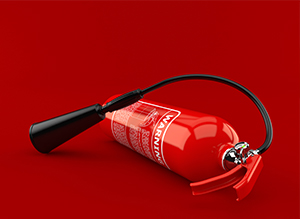 When it comes to protecting the property you own or manage, minimizing the risk of damage from fire is one of the most important things you can do. Every year, fires unexpectedly destroy homes and lives, and many of them are completely preventable.
When it comes to protecting the property you own or manage, minimizing the risk of damage from fire is one of the most important things you can do. Every year, fires unexpectedly destroy homes and lives, and many of them are completely preventable.
Between 2013 and 2017, cooking emerged as the leading cause of home fires and home fire injuries. In fact, nearly 74% of all apartment fires start in the kitchen and are directly related to cooking, according to The National Fire Incident Reporting System. As a manager, you can check all the boxes to make sure that your tenants are prepared, such as verifying smoke alarms are working to alert residents of a fire and that everyone has an escape plan in place in the event of a fire. But what’s more important is to be able to contain the fire and keep it from getting big enough to spread and cause significant damage.
Fires that are confined to a specific item, such as a fireplace or a cooking pan, aren’t normally responsible for significant property loss from flame damage, and they rarely result in serious injury, according to the U.S. Fire Administration. Of course, such fires can still result in the loss of contents within the building due to damage from smoke, fire, and water, but the amount of damage will be much less than if the fire is non-confined. In non-confined fires, the flames begin to spread and cause damage throughout the apartment unit or home. In the worst cases, they also spread to other units or even to nearby buildings.
Making sure rental homes and apartments have the proper tools for suppressing a fire when it breaks out is crucial to safety. While that’s important for every room in the home, nowhere is that more important than in the kitchen. Let’s look at four ways to put out kitchen fires before they get out of control.
No. 1: Use a fire extinguisher
A fire extinguisher is an essential piece of equipment that should be in every kitchen. Make sure that every apartment or rental unit is equipped with the right type of fire extinguisher and, just as importantly, make sure that residents know how to use it.
Fire extinguishers come in different classes and are designed to put out different types of fires. For kitchen grease fires, a Class B extinguisher, which is designed to be used on flammable liquids like grease, gasoline, and oil, or a Class K extinguisher, which is specifically for cooking oils and animal fats, will be effective.
A multipurpose extinguisher, such as an A-B, B-C or A-B-C extinguisher, is another option to allow tenants to use it for more than one purpose. Reviewing how to use a fire extinguisher properly is also important, since improper use of fire extinguishers can not only result in the fire not being extinguished but can lead to respiratory distress and even cardiac arrest.
No. 2: Cut off oxygen to the flame
It’s important to note that fighting a grease fire isn’t like fighting other types of fires; it should never be doused with water, as that can make the situation much worse.
However, a grease fire can’t continue to burn without oxygen, so putting a lid on a flaming pan is a quick and effective way to suppress a fire on the stove. To qualify that option, it’s important that the fire is still contained to the pan and is small enough for the resident to safely put a lid over it.
If there’s no lid available, a second, larger pot, pan or even a cooking sheet can be put over the flame. Of course, all of this requires the resident to respond very quickly, since fires can grow rapidly and get out of control in just a few minutes.
No. 3: Eliminate the heat source
If the fire has just started and is still small, turning off the burner can sometimes be enough to put it out. However, it’s important that residents know they should never try moving a flaming pan off the heat source, since that can cause liquids in the pan to splash and cause a bigger fire.
No. 4: Use StoveTop FireStop’s Rangehood
The most dependable way to suppress a fire on the stove quickly and safely is to use the Rangehood by StoveTop FireStop. This canister, which is mounted above a stove, activates when a direct, sustained flame comes in contact with the fuse on the bottom of the canister.
When activated, the canister makes a loud “pop” sound that will alert the resident and releases a fine, dry powder over the flames that suppresses the fire. Once the fire is suppressed, the resident can shut off the stove’s burner to prevent the fire from reigniting.
Why You Need a More Dependable Solution
While all of the above methods are effective for putting out grease fires on a stove, three of them depend on someone being near the stove when the fire breaks out and having the knowledge and presence of mind to take the right action. Unfortunately, statistics show that’s often not the case.
Unattended cooking equipment is the No. 1 cause of cooking fires and deaths, accounting for nearly one-third of deadly kitchen fires overall. Leaving the stove unattended, even for “just a minute” can have disastrous results. Nobody plans for a kitchen fire to happen, but they still continue to pose a threat to tenant safety. StoveTop FireStop provides around-the-clock monitoring to ensure that any fire occurring on the stove will be suppressed quickly and safely.
